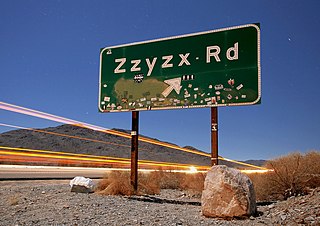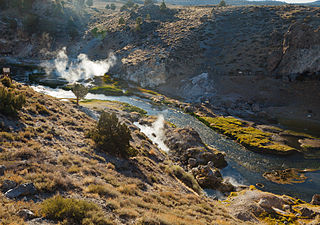
Mohave County is in the northwestern corner of the U.S. state of Arizona. As of the 2020 census, its population was 213,267. The county seat is Kingman, and the largest city is Lake Havasu City. It is the fifth largest county in the United States.

The Mojave River is an intermittent river in the eastern San Bernardino Mountains and the Mojave Desert in San Bernardino County, California, United States. Most of its flow is underground, while its surface channels remain dry most of the time, with the exception of the headwaters and several bedrock gorges in the lower reaches.

The Virgin River is a tributary of the Colorado River in the U.S. states of Utah, Nevada, and Arizona. The river is about 162 miles (261 km) long. It was designated Utah's first wild and scenic river in 2009, during the centennial celebration of Zion National Park.

Zzyzx, formerly Soda Springs, is an unincorporated community in San Bernardino County, California, within the boundaries of the Mojave National Preserve, managed by the National Park Service (NPS), an agency of the U.S. Department of Interior, as public land. It is the former site of the Zzyzx Mineral Springs and Health Spa and now the site of the Desert Studies Center. The site is also the location of Lake Tuendae, originally part of the spa, and now a refuge habitat of the endangered Mohave tui chub.

Naval Air Weapons Station (NAWS) China Lake is a large military installation in California that supports the research, testing and evaluation programs of the U.S. Navy. It is part of Navy Region Southwest under Commander, Navy Installations Command, and was originally known as Naval Ordnance Test Station (NOTS).

Curtis Howe Springer was an American radio evangelist, self-proclaimed medical doctor and Methodist minister best known for founding the Zzyzx Mineral Springs resort located within Southern California's Mojave Desert. He was also the host of well-known evangelical syndicated radio programs that were broadcast throughout the United States for several decades.

The Desert Studies Center (DSC) is a field station of the California State University located in Zzyzx, California, United States in the Mojave Desert. The purpose of the Center is to provide opportunities to conduct research, receive instruction and experience the Mojave Desert environment. It is officially operated by the California Desert Studies Consortium, a consortium of 7 CSU campuses: Dominguez Hills, Fullerton, Long Beach, Los Angeles, Northridge, San Bernardino and Cal Poly Pomona.
The Mohave tui chub is a species of fish. It is an endangered chub originally found only in the Mojave River. Even though named after the Mojave River, the fish's name is normally spelled "Mohave". It was named by ichthyologist Robert Rush Miller.

Lake Mohave is a reservoir on the Colorado River between the Hoover Dam and Davis Dam in Cottonwood Valley defining the border between Nevada and Arizona in the United States. This 67 mile stretch of the Colorado River flows past Boulder City, Nelson, Searchlight, Cottonwood Cove, Cal-Nev-Ari, and Laughlin to the west in Nevada and Willow Beach and Bullhead City to the east in Arizona. A maximum width of 4 miles wide and an elevation of 647 feet (197 m), Lake Mohave encompasses 28,260 acres of water. As Lake Mead lies to the north of the Hoover Dam, Lake Mohave and adjacent lands forming its shoreline are part of the Lake Mead National Recreation Area administered by the U.S. National Park Service.
The tui chub is a cyprinid fish native to western North America. Widespread in many areas, it is an important food source for other fish, including the cutthroat trout.

Soda Lake is a dry lake at the terminus of the Mojave River in the Mojave Desert of San Bernardino County, California. The lake has standing water during wet periods, and water can be found beneath the surface.

The Mojave Road, also known as Old Government Road, is a historic route and present day dirt road across what is now the Mojave National Preserve in the Mojave Desert in the United States. This rough road stretched 147 miles (237 km) from Beale's Crossing, to Fork of the Road location along the north bank of the Mojave River where the old Mojave Road split off from the route of the Old Spanish Trail/Mormon Road.

The bonytail chub or bonytail is a cyprinid freshwater fish native to the Colorado River basin of Arizona, California, Colorado, Nevada, New Mexico, Utah and Wyoming in the southwestern United States; it has been extirpated from the part of the basin in Mexico. It was once abundant and widespread in the basin, its numbers and range have declined to the point where it has been listed as endangered since 1980 (ESA) and 1986 (IUCN), a fate shared by the other large Colorado basin endemic fish species like the Colorado pikeminnow, humpback chub, and razorback sucker. It is now the rarest of the endemic big-river fishes of the Colorado River. There are 20 species in the genus Gila, seven of which are found in Arizona.

Hot Creek, starting as Mammoth Creek, is a stream in Mono County of eastern California, in the Western United States. It is within the Inyo National Forest.

Diamond Lake is a natural body of water in the southern part of the U.S. state of Oregon. It lies near the junction of Oregon Route 138 and Oregon Route 230 in the Umpqua National Forest in Douglas County. It is located between Mount Bailey to the west and Mount Thielsen to the east; it is just north of Crater Lake National Park.
Willow Beach is located on the Arizona side of the Colorado River between Lake Mead and Lake Mohave. Both Lake Mead and Lake Mohave are part of the Lake Mead National Recreation Area administered by the U.S. National Park Service.

The Summer Lake Wildlife Area is a 29.6-square-mile (77 km2) wildlife refuge located on the northwestern edge of the Great Basin drainage in south-central Oregon. It is administered by the Oregon Department of Fish and Wildlife. The refuge is an important stop for waterfowl traveling along the Pacific Flyway during their spring and fall migrations. The Summer Lake Wildlife Area also provides habitat for shorebirds and other bird species as well as wide variety of mammals and several fish species. The Ana River supplies the water for the refuge wetlands.
The Saratoga Springs pupfish is a subspecies of the Amargosa pupfish of the family Cyprinodontidae. The native population is endemic to Saratoga Springs, a small wetland in Death Valley National Park in the United States.
Siphateles is a genus of fish belonging to the family Cyprinidae, native to the Western United States. They were formerly placed in the genus Gila.

The Owens tui chub was described in 1973 as a subspecies of tui chub endemic to the Owens River Basin in Eastern California, United States. The Owens tui chub is distinguished from its closest relative, the Lahontan tui chub, by scales with a weakly developed or absent basal shield, 13 to 29 lateral and apical radii, also by the structure of its pharyngeal arches, the number of anal fin rays, 10 to 14 gill rakers, and 52 to 58 lateral line scales. Dorsal and lateral coloration varies from bronze to dusky green, grading to silver or white on the belly. It may reach a total length of 30 centimetres (12 in). Owens tui chub are believed to be derived from Lahontan Basin tui chub that entered the Owens Basin from the north during the Pleistocene Epoch.


















